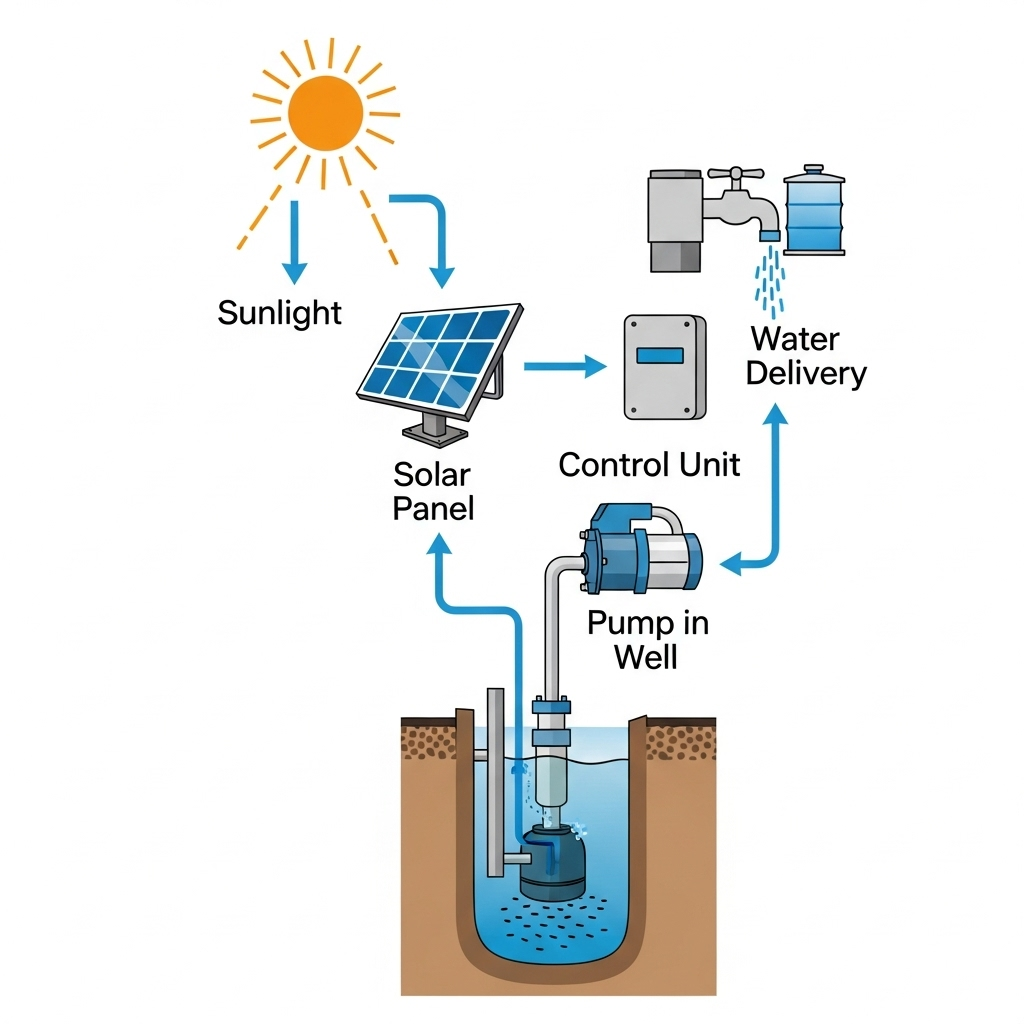When you’re seeking reliable water access without the inconvenience of high electricity bills, a Grundfos solar well pump provides precisely what you need. These innovative systems harness solar energy to provide consistent access to groundwater for a range of applications, from agricultural irrigation to residential water supply.
The beauty of solar-powered water pumps lies in their independence from external sources. There is no requirement for a grid connection, no monthly electricity bills are incurred, and the environmental impact is minimal. Grundfos has engineered these systems to operate reliably in various conditions, making them ideal for remote locations or anyone seeking to reduce their carbon footprint.
Let’s explore what makes these solar well pumps such a wise investment for sustainable water management.
What Makes Grundfos Solar Well Pumps Different

Grundfos didn’t just slap solar panels onto a regular pump and call it sustainable. They redesigned the entire system from the ground up to maximize solar efficiency and reliability.
The key difference is the intelligent microcontroller technology. This innovative system constantly monitors available sunlight and adjusts pump performance accordingly. On bright sunny days, you get maximum water flow. During cloudy periods, the system scales back to maintain steady operation without draining the solar battery.
Flow Rate Flexibility:
Grundfos offers models with flow rates from 0.5 to 6 cubic meters per hour. This range perfectly covers the needs of most residential and small-scale agricultural areas.
Built for Durability:
These aren’t cheap knockoffs that break after a season. Grundfos utilizes corrosion-resistant materials specifically designed to withstand harsh outdoor conditions for years.
Compact Design:
Unlike bulky traditional pump systems, Grundfos solar pumps have a streamlined profile that’s easy to install and doesn’t dominate your landscape.
Top 3 Key Features That Matter
1. Solar Panel Efficiency
The solar panels that come with Grundfos systems are explicitly sized for pump requirements. They’re lightweight, easy to mount, and designed to capture maximum sunlight even at less-than-perfect angles. The intelligent power management ensures you’re getting the most water per watt of solar energy.
2. Pump Performance Specs
Here’s what you can expect from different Grundfos models:
Model Type | Flow Rate (m³/hour) | Best Use Case | Head Range |
|---|---|---|---|
Light Duty | 0.5 – 1.5 | Small residential, garden irrigation | Up to 50m |
Medium Duty | 2.0 – 4.0 | Large homes, small farms | Up to 80m |
Heavy Duty | 4.5 – 6.0 | Agricultural irrigation, livestock | Up to 120m |
3. Smart Control System
The microcontroller isn’t just a fancy add-on; it’s the brain that makes everything work smoothly. It prevents the pump from running dry, optimizes water delivery based on solar conditions, and protects the system from damage.
Real-World Benefits You’ll Notice
- Lower Operating Costs: Once installed, your only ongoing cost is occasional maintenance. No monthly electricity bills for water pumping.
- Reliable Water Access: The system works consistently, even during partial cloud cover. The smart controls ensure steady water flow throughout the day.
- Minimal Maintenance: Unlike conventional pumps with oil changes and complex electrical systems, Grundfos solar pumps have fewer moving parts and simpler maintenance requirements.
- Environmental Impact: You’re eliminating the carbon emissions associated with grid-powered water pumping while using renewable energy.
What to Consider Before Buying
1. Upfront Investment
The initial cost is higher than that of traditional electric pumps. You’re paying for advanced solar technology and high-quality materials that last longer. Most users find the system pays for itself within 3-5 years through energy savings.
2. Installation Requirements
While the design is user-friendly, proper installation requires some technical knowledge. You’ll need to position solar panels for optimal sun exposure and ensure proper plumbing connections. If you’re not comfortable with electrical and plumbing work, factor in professional installation costs.
3. Performance Limitations
Solar pumps work best in areas with consistent sunlight. If you’re in a region with frequent overcast conditions, you might need battery backup, solar trackers, or a larger solar array to maintain consistent performance.
How Grundfos Compares to Other Solar Pumps
Many cheaper solar pumps flood the market, but they often fail within a year or two. Grundfos costs more upfront but delivers superior reliability and efficiency. The intelligent controls and high-quality construction result in fewer breakdowns and better long-term value.
- Engineering Quality: Grundfos has decades of pump engineering experience. Their solar systems benefit from this expertise.
- Customer Support: When issues arise, Grundfos provides real technical support, not just a warranty disclaimer.
- Longevity: Users consistently report 10+ years of reliable operation with minimal maintenance.
Real Performance in Different Applications
1. Agricultural Use
For irrigation applications, the Grundfos submersible pump excels at providing a steady water flow throughout the growing season. Farmers report significant savings on electricity costs while maintaining reliable irrigation for their crops.
2. Residential Applications
Homeowners utilize these systems for a wide range of applications, from garden irrigation to whole-house water supply. The ability to operate independently of the electrical grid makes them perfect for remote properties or backup water systems.
3. Livestock Watering
The consistent, quiet operation makes Grundfos solar pumps ideal for livestock watering systems. Animals aren’t spooked by noise, and ranchers enjoy the reliability of solar-powered water access.
Beyond Well Water: What Else Can You Power?
Here’s something most people don’t realize when they first get a Grundfos solar pump – you’re not just buying a well pump. You’re getting the heart of a complete water system that can handle way more than you probably thought about.
Filling Tanks and Keeping Pressure That steady 0.5-6 m³/hour flow isn’t just perfect for direct use – it’s fantastic for filling storage tanks and keeping pressure steady throughout a whole property. I’ve seen folks use these systems to run everything from a single outdoor spigot to complete off-grid cabin water systems.
The Stuff You Didn’t Think About Once you’ve got reliable water coming up from the ground, you start seeing opportunities everywhere:
- Remote bathrooms: Finally, that outbuilding can have running water without trenching power lines
- Wash stations: Perfect for cleaning tools, equipment, or just washing hands after working outside
- Outdoor drinking fountains: Great for trail access points, campsites, or anywhere people need clean drinking water
- Emergency backup: When the power goes out, you’ve still got water flowing
Whether you’re just filling a 100-gallon tank or trying to maintain pressure for multiple outlets, the microcontroller adjusts automatically. Just make sure you account for your highest water demand and plan your storage accordingly.
Installation Tips for Best Results
- Solar Panel Placement: Mount panels facing south (in the Northern Hemisphere) at an angle equal to your latitude for optimal year-round performance.
- Water Source Depth: Measure your well depth accurately. Grundfos offers different models optimized for various head requirements.
- Professional Help: If you’re unsure about electrical connections or pump sizing, consult with specialists. The Solar Store can help match the right Grundfos system to your specific needs.
Maintenance Requirements
One of the most significant advantages of Grundfos solar pumps is their low maintenance needs:
Annual Tasks: Check solar panel cleanliness, inspect electrical connections, verify pump operation.
Every 2-3 Years: Professional system inspection, controller software updates if available.
Long-term: Most components last 10 years or more with proper care. The pump motor typically needs replacement after 15-20 years of operation.
Is a Grundfos Solar Well Pump Right for You?
These systems work best when you have:
- Consistent sunlight exposure (at least 4-6 hours daily)
- Water needs within the 0.5-6 m³/hour range
- Interest in reducing long-term operating costs
- Remote location or unreliable grid power
- Environmental consciousness about energy use
If you’re dealing with high electricity costs for water pumping, live in a sunny climate, or want energy independence, a Grundfos solar well pump makes excellent financial and environmental sense.
Frequently Asked Questions
How long do Grundfos solar well pumps last? With proper maintenance, expect 15-20 years of reliable operation. The solar panels typically last 25 years or more, while the pump motor may need replacement after 15-20 years.
Do they work on cloudy days? Yes, though at reduced capacity. The intelligent controller adjusts performance based on available solar energy, ensuring some water flow even during overcast conditions.
What’s the payback period? Most users see full payback within 3-5 years through eliminated electricity costs, depending on local utility rates and water usage patterns.
Can I install it myself? Basic installation is possible for those with plumbing and electrical experience. However, proper system sizing and optimal placement often benefit from professional consultation.
How much water can they pump daily? Daily output depends on the number of sunlight hours and the pump model. A 2 m³/hour pump with 6 hours of good sun can deliver 12,000 liters per day.
What happens if the pump runs out of water? Grundfos systems include dry-run protection that automatically shuts down the pump when water levels drop too low, preventing damage to the motor.








